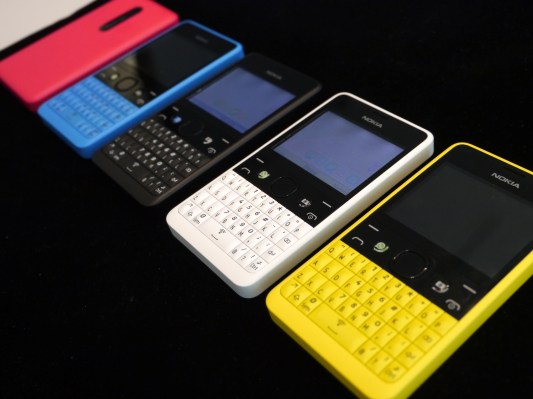Microsoft’s acquisition of Nokia’s Devices & Services division for $7.2 billion is a bet on emerging markets and a continuation of Nokia’s emphasis on “connecting the next billion” users. In order to make that strategy pay off, Microsoft has to figure out how to thrive where Nokia floundered. Feature phones were a key part of Nokia’s strategy, especially in emerging markets like India, where it recently announced 2 billion downloads from the Nokia Apps store. As worldwide sales of smartphones start to overtake feature phones, however, it might be a smarter bet for Microsoft to concentrate on creating low-cost smartphones if it wants those next billion users to chose Windows Phone instead of Android.
One potential strategy is selling off Nokia’s feature phone business. According to the PowerPoint presentation Microsoft made to explain its rationale for the acquisition, the company said the deal could create cost synergies of $600 million within 18 months after its close. But as Juha-Pekka Helminen, former Director of Strategy at Nokia, noted on Twitter, consolidating marketing and sales and supply chains would not add up to $600 million. One way Microsoft can achieve those savings is by offloading Nokia’s feature phone business, which is in decline but still making money. This would also allow Microsoft to focus more resources on tripling its current smartphone market share from 4% to 15% within five years, a goal it laid out in its PowerPoint.
In Nokia’s press conference earlier today, CEO Stephen Elop said that the acquisition will allow Nokia’s device division to accelerate its growth. In return, Microsoft can extend its service offerings to a far wider group of people around the world, using Nokia’s devices as an “on-ramp” to Windows Phone. Feature phones are still important in emerging markets because they are the first (and, in some cases, only) point of entry to the Internet for many users. But the landscape is changing–last month, Gartner reported that in Q2 2013 smartphone sales exceeded feature phone sales for the first time.
This was driven mainly by inexpensive Android-powered devices, which is troublesome news for Nokia. Nokia shipped just 61 million feature phones in Q2 2013, down from 83 million in the year ago quarter. But despite overwhelming competition from Android, sales of Nokia’s smartphones still managed to grow in that same timeframe, thanks to its broad portfolio of devices at different price points. Nokia’s Windows Phone-powered Lumia sales increased 112.7% in Q2 2013, according to Gartner.
As part of the deal announced today, Microsoft acquired Nokia’s Asha brand outright. If Microsoft decides to hold onto Nokia’s feature phone business, it has to convince current feature phone users to stay within the Windows Phone ecosystem when they upgrade to smartphones instead of turning to Android. Not only that, but Microsoft must also now compete with its Windows Phone licensees, including Samsung and HTC–another reason why it might want to sell off Asha and Nokia’s other feature phone lines while they are still profitable in favor of focusing on inexpensive smartphones.
All major U.S. tech companies that sell both software and hardware–including Apple–have eventually turned to emerging markets for growth when their business in domestic and mature markets began to slow, so it’s unsurprising that Microsoft sees its acquisition of Nokia as a way to gain a bigger foothold around the world.
After the failure of Windows RT, Microsoft is banking its business on Windows 8 and Windows Phone. Acquiring Nokia’s D&S division gives Microsoft a chance to execute its strategy for both operating systems in a more vertically-integrated way similar to Apple’s business model for iOS devices. Microsoft currently makes a royalty gross margin of less than $10 per Windows Phone-based Nokia handset sold. After the acquisition, the company says that figure will increase to more than $40 per unit, which in turn will enable it to invest more in the Windows Phone ecosystem.
Selling off Nokia’s feature phone business would enable Microsoft to pour more resources into developing smartphones similar to the Lumia 625, its first affordable 4G handset. Lower-price points are attractive to people living in countries where smartphone adoption is still in its early stages, while 4G accessibility is a selling point for developed markets. By releasing more devices like the Lumia 625, Microsoft can apply a two-pronged strategy to expanding Windows Phone’s market share in a bid to challenge Android’s dominance.
